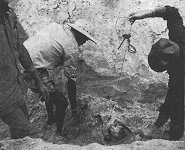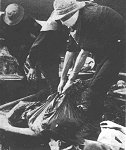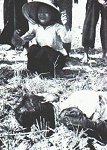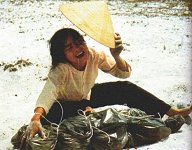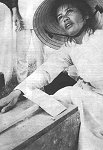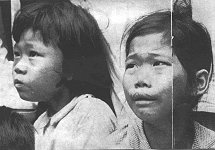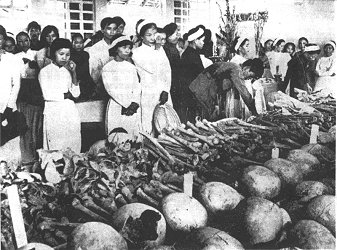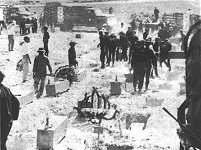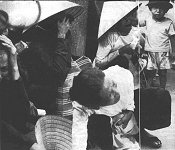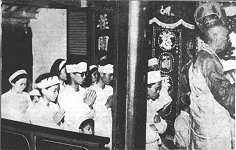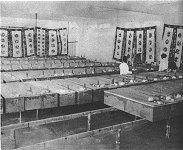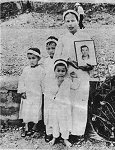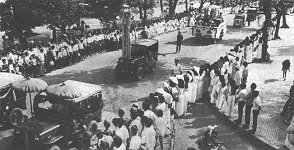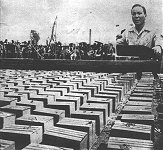(An Excerpt from the Viet Cong Strategy of Terror, by Mr. Douglas Pike, p. 23-39) (In Memory of the 7,600 civilians murdered in Hue by Vietnamese communists)
The city of Hue is one of the saddest cities of our earth, not simply because of what happened there in February 1968, unthinkable as that was. It is a silent rebuke to all of us, inheritors of 40 centuries of civilization, who in our century have allowed collectivist politics-abstractions all-to corrupt us into the worst of the modern sins, indifference to inhumanity. What happened in Hue should give pause to every remaining civilized person on this planet. It should be inscribed, so as not to be forgotten, along with the record of other terrible visitations of man's inhumanity to man which stud the history of the human race. Hue is another demonstration of what man can bring himself to do when he fixes no limits on political action and pursues incautiously the dream of social perfectibility. What happened in Hue, physically, can be described with a few quick statistics. A Communist force which eventually reached 12,000 invaded the city the night of the new moon marking the new lunar year, January 30, 1968. It stayed for 26 days and then was driven out by military action. In the wake of this Tet offensive, 5,800 Hue civilians were dead or missing. It is now known that most of them are dead. The bodies of most have since been found in single and mass graves throughout Thua Thien Province which surrounds this cultural capital of Vietnam. Such are the skeletal
facts, the important statistics. Such is what the incurious word knows
any thing at all about Hue, for this is what was written, modestly by the
word's press. Apparently it made no impact on the world's mind or conscience.
For there was no agonized outcry. No demonstration at North Vietnamese
embassies around the world. In a tone beyond bitterness, the people there
will tell you that the world does not know what happened in Hue or, if
it does, does not care.
The Battle The Battle of Hue was part of the Communist Winter-Spring campaign of 1967-68. The entire campaign was divided into three phases: Phase I came in October, November, and December of 1967 and entailed "coordinated fighting methods," that is, fairly large, set-piece battles against important fixed installations or allied concentrations. The battles of Loc Ninh in Binh Long Province, Dak To in Kontum Province, and Con Tien in Quang Tri Province, all three in the mountainous interior of South Vietnam near the Cambodian and Lao borders, were typical and, in fact, major elements in Phase I. Phase II came in January, February, and March of 1968 and involved great use of "independent fighting methods," that is, large numbers of attacks by fairly small units, simultaneously, over a vast geographic area and using the most refined and advanced techniques of guerrilla war. Whereas Phase I was fought chiefly with North Vietnamese Regular (PAVN) troops (at that time some 55,000 were in the South), Phase II was fought mainly with Southern Communist (PLAF) troops. The crescendo of Phase II was the Tet offensive in which 70,000 troops attacked 32 of South Vietnam's largest population centres, including the city of Hue. Phase III, in April, May, and June of 1968, originally was to have combined the independent and coordinated fighting methods, culminating in a great fixed battle somewhere. This was what captured documents guardedly referred to as the "second wave". Possibly it was to have been Khe Sanh, the U.S. Marine base in the far northern corner of South Vietnam. Or perhaps it was to have been Hue. There was no second wave chiefly because events in Phases I and II did not develop as expected. Still, the war reached its bloodiest tempo in eight years then, during the period from the Battle of Hue in February until the lifting of the siege of Khe Sanh in late summer. American losses during those three months averaged nearly 500 killed per week; the South Vietnamese (GVN) losses were double that rate; and the PAVN-PLAF losses were nearly eight times the American loss rate. In the Winter-Spring Campaign, the Communists began with about 195,000 PLAF main force and PAVN troops. During the nine months they lost (killed or permanently disabled) about 85,000 men. The Winter-Spring Campaign was an all-out Communist bid to break the back of the South Vietnamese armed forces and drive the government, along with the Allied forces, into defensive city enclaves. Strictly speaking, the Battle of Hue was part of Phase I rather than Phase II since it employed "co-ordinated fighting methods" and involved North Vietnamese troops rather than southern guerrillas. It was fought, on the Communist side, largely by two veteran North Vietnamese army divisions: The Fifth 324-B, augmented by main forces battalions and some guerrilla units along with some 150 local civilian commissars and cadres. Briefly the Battle of Hue consisted of these major developments: The initial Communist assault, chiefly by the 800th and 802nd battalions, had the force and momentum to carry it across Hue. By dawn of the first day the Communists controlled all the city except the headquarters of the First ARVN Division and the compound housing American military advisors. The Vietnamese and Americans moved up reinforcements with orders to reach the two holdouts and strengthen them. The Communists moved up another battalion, the 804th, with orders to intercept the reinforcement forces. This failed, the two points were reinforced and never again seriously threatened. The battle then took on the aspects of a siege. The Communists were in the Citadel and on the western edge of the city. The Vietnamese and Americans on the other three sides, including that portion of Hue south of the river, determined to drive them out, hoping initially to do so with artillery fire and air strikes. But the Citadel was well built and soon it became apparent that if the Communists' orders were to hold, they could be expelled only by city warfare, fighting house by house and block by block, a slow and costly form of combat. The order was given. By the third week
of February the encirclement of the Citadel was well under way and Vietnamese
troops and American Marines were advancing yard by yard through the Citadel.
On the morning of February 24, Vietnamese First Division soldiers tore
down the Communist flag that had flown for 24 days over the outer wall
and hoisted their own. The battle was won, although sporadic fighting would
continue outside the city. Some 2,500 Communists died during the battle
and another 2,500 would die as Communists elements were pursued beyond
Hue. Allied dead were set at 357.
The Finds In the chaos that existed following the battle, the first order of civilian business was emergency relief, in the form of food shipments, prevention of epidemics, emergency medical care, etc. Then came the home rebuilding effort. Only later did Hue begin to tabulate its casualties. No true post-attack census has yet been taken. In March local officials reported that 1,900 civilians were hospitalized with war wounds and they estimated that some 5,800 persons were unaccounted for. The first discovery of Communist victims came in the Gia Hoi High School yard, on February 26 ; eventually 170 bodies were recovered. In the next few months 18 additional grave sites were found, the largest of which were Tang Quang Tu Pagoda (67 victims), Bai Dau (77), Cho Thong area (an estimated 100), the imperial tombs area (201), Thien Ham (approximately 200), and Dong Gi (approximately 100). In all, almost 1,200 bodies were found in hastily dug, poorly concealed graves. At least half of these showed clear evidence of atrocity killings: hands wired behind backs, rags stuffed in mouths, bodies contorted but without wounds (indicating burial alive). The other nearly 600 bore wound marks but there was no way of determining whether they died by firing squad or incidental to the battle. The second major group of finds was discovered in the first seven months of 1969 in Phu Thu district-the Sand Dune Finds and Le Xa Tay-and Huong Thuy district-Xuan Hoa-Van Duong-in late March and April. Additional grave sites were found in Vinh Loc district in May and in Nam Hoa district in July. The largest of this group were the Sand Dune Finds in the three sites of Vinh Luu, Le Xa Dong and Xuan 0 located in rolling, grasstufted sand dune country near the South China Sea. Separated by salt-marsh valleys, these dunes were ideal for graves. Over 800 bodies were uncovered in the dunes. In the Sand Dune Find, the pattern had been to tie victims together in groups of 10 or 20, line them up in front of a trench dug by local corvee labour and cut them down with submachine gun (a favourite local souvenir is a spent Russian machine gun shell taken from a grave). Frequently the dead were buried in layers of three and four, which makes identification particularly difficult. In Nam Hoa district came the third, or Da Mai Creek Find, which also has been called the Phu Cam death march, made on September 19, 1969. Three Communist defectors told intelligence officers of the 101st Airborne Brigade that they had witnessed the killing of several hundred people at Da Mai Creek, about 10 miles south of Hue, in February of 1968. The area is wild, unpopulated, virtually inaccessible. The Brigade sent in a search party, which reported that the stream contained a large number of human bones. By piecing together bits of information, it was determined that this is what happened at Da Mai Creek: On the fifth day of Tet in the Phu Cam section of Hue, where some three-quarters of the City's 40,000 Roman Catholics lived, a large number of people had taken sanctuary from the battle in a local church, a common method in Vietnam of escaping war. Many in the building were not in fact Catholic. A Communist political commissar arrived at the church and ordered out about 400 people, some by name and some apparently because of their appearance (prosperous looking and middle-aged businessmen, for example). He said they were going to the "liberated area" for three days of indoctrination, after which each could return home. They were marched nine kilometres south to a pagoda where the Communists had established a headquarters. There 20 were called out from the group, assembled before a drumhead court, tried, found guilty, executed and buried in the pagoda yard. The remainder were taken across the river and turned over to a local Communist unit in an exchange that even involved banding the political commissar a receipt. It is probable that the commissar intended that their prisoners should be re-educated and returned, but with the turnover, matters passed from his control. During the next several days, exactly how many is not known, both captive and captor wandered the countryside. At some point the local Communists decided to eliminate witnesses: Their captives were led through six kilometres of some of the most rugged terrain in Central Vietnam, to Da Mai Creek. There they were shot or brained and their bodies left to wash in the running stream. The 101st Airborne Brigade burial detail found it impossible to reach the creek overland, roads being non-existent or impassable. The creek's foliage is what in Vietnam is called double-canopy, that is, two layers, one consisting of brush and trees close to the ground, and the second of tall trees whose branches spread out high above. Beneath is permanent twilight. Brigade engineers spent two days blasting a hole through the double-canopy by exploding dynamite dangled on long wires beneath their hovering helicopters. This cleared a landing pad for helicopter hearses. Quite clearly this was a spot where death could be easily hidden even without burial. The Da Mai Creek bed, for nearly a hundred yards up the ravine, yielded skulls, skeletons and pieces of human bones. The dead had been left above ground (for the animists among them, this meant their souls would wander the lonely earth forever, since such is the fate of the unburied dead), and 20 months in the running stream had left bones clean and white. Local authorities later released a list of 428 names of personswhom they said had been positively identified from the creek bed remains. The Communists' rationale for their excesses was elimination of "traitors to the revolution." The list of 428 victims breaks down as follows: 25 per cent military: two officers, the rest NCO's and enlisted men; 25 per cent students; 50 per cent civil servants, village and hamlet officials, service personnel of various categories, and ordinary workers. The fourth or Phu Thu Salt Flat Finds came in November, 1969, near the fishing village of Luong Vien some ten miles east of Hue, another desolate region. Government troops early in the month began an intensive effort to clear the area of remnants of the local Communist organization. People of Luong Vien, population 700, who had remained silent in the presence of troops for 20 months apparently felt secure enough from Communist revenge to break silence and lead officials to the find. Based on descriptions from villagers whose memories are not always clear, local officials estimate the number of bodies at Phu Thu to be at least 300 and possibly 1,000. The story remains
uncompleted. If the estimates by Hue officials are even approximately correct,
nearly 2,000 people are still missing. Re-capitulation of the dead and
missing.

After
the battle, the Goverment of South Viet Nam's total estimated
[1] SEATO: South
East Asia Organization.
Communist Rationale The killing in Hue that added up to the Hue Massacre far exceeded in numbers any atrocity by the Communists previously in South Vietnam. The difference was not only one in degree but one in kind. The character of the terror that emerges from an examination of Hue is quite distinct from Communist terror acts elsewhere, frequent or brutal as they may have been. The terror in Hue was not a morale building act-the quick blow deep into the enemy's lair which proves enemy vulnerability and the guerrilla's omnipotence and which is quite different from gunning down civilians in areas under guerrilla control. Nor was it terror to advertise the cause. Nor to disorient and psychologically isolate the individual, since the vast majority of the killings were done secretly. Nor, beyond the blacklist killings, was it terror to eliminate opposing forces. Hue did not follow the pattern of terror to provoke governmental over-response since it resulted in only what might have been anticipated-government assistance. There were elements of each objective, true, but none serves to explain the widespread and diverse pattern of death meted out by the Communists. What is offered here is a hypothesis which will suggest logic and system behind what appears to be simple, random slaughter. Before dealing with it, let us consider three facts which constantly reassert themselves to a Hue visitor seeking to discover what exactly happened there and, more importantly, exactly why it happened. All three fly in the face of common sense and contradict to a degree what has been written. Yet, in talking to all sources-province chief, police chief, American advisor, eye witness, captured prisoner, hoi chanh (defector) or those few who miraculously escaped a death scene-the three facts emerge again and again. The first fact, and perhaps the most important, is that despite contrary appearances virtually no Communist killing was due to rage, frustration, or panic during the Communist withdrawal at the end. Such explanations are frequently heard, but they fail to hold up under scrutiny. Quite the contrary, to trace back any single killing is to discover that almost without exception it was the result of a decision rational and justifiable in the Communist mind. In fact, most killings were, from the Communist calculation, imperative. The second fact is that, as far as can be determined, virtually all killings were done by local Communist cadres and not by the ARVN troops or Northerners or other outside Communists. Some 12,000 ARVN troops fought the battle of Hue and killed civilians in the process but this was incidental to their military effort. Most of the 150 Communist civilian cadres operating within the city were local, that is from the Thua Thien province area. They were the ones who issued the death orders. Whether they acted on instructions from higher headquarters (and the Communist organizational system is such that one must assume they did), and, if so, what exactly those orders were, no one yet knows for sure. The third fact is that beyond "example" executions of prominent "tyrants", most of the killings were done secretly with extraordinary effort made to hide the bodies. Most outsiders have a mental picture of Hue as a place of public executions and prominent mass burial mounds of fresh-turned earth. Only in the early days were there well-publicized executions and these were relatively few. The burial sites in the city were easily discovered because it is difficult to create a graveyard in a densely populated area without someone noticing it. All the other finds were well hidden, all in terrain lending itself to concealment, probably the reason the sites were chosen in the first place. A body in the sand dunes is as difficult to find as a seashell pushed deep into a sandy beach over which a wave has washed. Da Mai Creek is in the remotest part of the province and must have required great exertion by the Communists to lead their victims there. Had not the three hoi chanh led searchers to the wild uninhabited spot the bodies might well remain undiscovered to this day. A visit to all sites leaves one with the impression that the Communists made a major effort to hide their deeds. The hypothesis offered here connects and fixes in time the Communist assessment of their prospects for staying in Hue with the kind of death order issued. It seems clear from sifting evidence that they had no single unchanging assessment with regard to themselves and their future in Hue, but rather that changing situations during the course of the battle altered their prospects and their intentions. It also seems equally clear from the evidence that there was no single Communist policy on death orders; instead the kind of death order issued changed during the course of the battle. The correlation between these two is high and divides into three phases. The hypothesis therefore is that as Communist plans during the Battle of Hue changed so did the nature of the death orders issued. This conclusion is based on overt Communist statements, testimony by prisoners1 and hoi chanh, accounts of eyewitnesses, captured documents and the internal logic of the Communist situation. Thinking in Phase I was well expressed in a Communist Party of South Vietnam (PRP) resolution issued to cadres on the eve of the offensive: Be sure that the liberated ... cities are successfully consolidated. Quickly activate armed and political units, establish administrative organs at all echelons, promote (civilian) defence and combat support activities, get the people to establish an air defence system and generally motivate them to be ready to act against the enemy when he counterattacks..." This was the limited view at the start - held momentarily. Subsequent developments in Hue were reported in different terms. Hanoi Radio on February 4 said: "After one hour's fighting the Revolutionary Armed Forces occupied the residence of the puppet provincial governor (in Hue), the prison and the offices of the puppet administration... The Revolutionary Armed Forces punished most cruel agents of the enemy and seized control of the streets... rounded up and punished dozen of cruel agents and caused the enemy organs of control and oppression to crumble... During the brief stay in Hue, the civilian cadres, accompanied by execution squads, were to round up and execute key individuals whose elimination would greatly weaken the government's administrative apparatus following Communist withdrawal. This was the blacklist period, the time of the drumhead court. Cadres with lists of names and addresses on clipboards appeared and called into kangaroo court various "enemies of the Revolution." Their trials were public, usually in the court-yard of a temporary Communist headquarters. The trials lasted about ten minutes each and there are no known not-guilty verdicts. Punishment, invariably execution, was meted out immediately. Bodies were either hastily buried or turned over to relatives. Singled out for this treatment were civil servants, especially those involved in security or police affairs, military officers and some non-commissioned officers, plus selected non-official but natural leaders of the community, chiefly educators and religionists. With the exception of a particularly venomous attack on Hue intellectuals, the Phase I pattern was standard operating procedure for Communists in Vietnam. It was the sort of thing that had been going on systematically in the villages for ten years. Permanent blacklists, prepared by zonal or inter-zone party headquarters have long existed for use throughout the country, whenever an opportunity presents itself. However, not all
the people named in the lists used in Hue were liquidated. There were a
large number of people who obviously were listed, who stayed in the city
throughout the battle, but escaped. Throughout the 24-day period the Communist
cadres were busy hunting down persons on their blacklists, but after a
few days their major efforts were turned into a new channel.
Hue: Phase II In the first few days, the Tet offensive affairs progressed so well for the Communists in Hue (although not to the south, where party chiefs received some rather grim evaluations from cadres in the midst of the offensive in the Mekong Delta) that for a brief euphoric moment they believed they could hold the city. Probably the assessment that the Communists were in Hue to stay was not shared at the higher echelons, but it was widespread in Hue and at the Thua Thien provincial level. One intercepted Communist message, apparently written on February 2, exhorted cadres in Hue to hold fast, declaring; "A new era, a real revolutionary period has begun (because of our Hue victories) and we need only to make swift assault (in Hue) to secure our target and gain total victory." The Hanoi official party newspaper, Nhan Dan, echoed the theme: "Like a thunderbolt, a general offensive has been hurled against the U.S. and the puppets... The U.S.-puppet machine has been duly punished. The puppet administrative organs... have suddenly collapsed. The Thieu-Ky administration cannot escape from complete collapse. The puppet troops have become extremely weak and cannot avoid being completely exterminated." Of course, some of this verbiage is simply exhortation to the faithful, and, as is always the case in reading Communist output, it is most difficult to distinguish between belief and wish. But testimony from prisoners and hoi chanh, as well as intercepted battle messages, indicate that both rank and file and cadres believed for a few days they were permanently in Hue, and they acted accordingly. Among their acts was to extend the death order and launch what in effect was a period of social reconstruction, Communist style. Orders went out, apparently from the provincial level of the party, to round up what one prisoner termed "social negatives," that is, those individuals or members of groups who represented potential danger or liability in the new social order. This was quite impersonal, not a blacklist of names but a blacklist of titles and positions held in the old society, directed not against people as such but against "social units." As seen earlier in North Vietnam and in Communist China, the Communists were seeking to break up the local social order by eliminating leaders and key figures in religious organizations (Buddhist bonzes, Catholic priests), political parties (four members of the Central Committee of Vietnam), social movements such as women's organizations and youth groups, including what otherwise would be totally inexplicable, the execution of pro-Communist student leaders from middle and upper class families. In consonance with this, killing in some instances was done by family unit. In one well-documented case during this period a squad with a death order entered the home of a prominent community leader and shot him, his wife, his married son and daughter-in-law, his young unmarried daughter, a male and female servant and their baby. The family cat was strangled; the family dog was clubbed to death; the goldfish scooped out of the fish-bowl and tossed on the floor. When the Communists left, no life remained in the house. A "social unit" had been eliminated. Phase II also saw an intensive effort to eliminate intellectuals, who are perhaps more numerous in Hue than elsewhere in Vietnam. Surviving Hue intellectuals explain this in terms of a long-standing Communist hatred of Hue intellectuals, who were anti-Communist in the worst or most insulting manner: they refused to take Communism seriously. Hue intellectuals have always been contemptuous of Communist ideology, brushing it aside as a latecomer to the history of ideas and not a very significant one at that. Hue, being a bastion of traditionalism, with its intellectuals steeped in Confucian learning intertwined with Buddhism, did not, even in the fermenting years of the 1920s, and 1930s, debate the merits of Communism. Hue ignored it. The intellectuals in the university, for example, in a year's course in political thought dispense with Marxism-Leninism in a half hour lecture, painting it as a set of shallow barbarian political slogans with none of the depth and time-tested reality of Confucian learning, nor any of the splendor and soaring humanism of Buddhist thought. Since the Communist, especially the Communist from Hue, takes his dogma seriously, he can become demoniac when dismissed by a Confucian as a philosophic ignoramus, or by a Buddhist as a trivial materialist. Or, worse than being dismissed, ignored through the years. So with the righteousness of a true believer, he sought to strike back and eliminate this challenge of indifference. Hue intellectuals now say the hunt-down in their ranks has taught them a hard lesson, to take Communism seriously, if not as an idea, at least as a force loose in their world. The killings in Phase
II perhaps accounted for 2,000 of the missing. But the worst was not yet
over.
Hue: Phase III Inevitably, and as the leadership in Hanoi must have assumed all along, considering the forces ranged against it, the battle in Hue turned against the Communists. An intercepted PAVN radio message from the Citadel, February 22, asked for permission to withdraw. Back came the reply: permission refused, attack on the 23rd. That attack was made, a last, futile one. On the 24th the Citadel was taken. That expulsion was
inevitable was apparent to the Communists for at least the preceding week.
It was then that Phase III began, the cover-the-traces period. Probably
the entire civilian underground apparat in Hue had exposed itself during
Phase II. Those without suspicion rose to proclaim their identity. Typical
is the case of one Hue resident who described his surprise on learning
that his next door neighbour was the leader of a phuong (which made him
10th to 15th ranking Communist civilian in the city), saying in wonder,
"I'd known him for 18 years and never thought he was the least interested
in politics." Such a cadre could not go underground again unless there
was no one around who remembered him.
Hence Phase III, elimination of witnesses. Probably the largest number of killings came during this period and for this reason. Those taken for political indoctrination probably were slated to be returned. But they were local people as were their captors; names and faces were familiar. So, as the end approached they became not just a burden but a positive danger. Such undoubtedly was the case with the group taken from the church at Phu Cam. Or of the 15 high school students whose bodies were found as part of the Phu Thu Salt Flat find. Categorization in a hypothesis such as this is, of course, gross and at best only illustrative. Things are not that neat in real life. For example, throughout the entire time the blacklist hunt went on. Also, there was revenge killing by the Communists in the name of the party, the so-called "revolutionary justice." And undoubtedly there were personal vendettas, old scores settled by individual party members. The official Communist view of the killing in Hue was contained in a book written and published in Hanoi: "Actively combining their efforts with those of the PLAF and population, other self-defence and armed units of the city (of Hue) arrested and called to surrender the surviving functionaries of the puppet administration and officers and men of the puppet army who were skulking. Die-hard cruel agents were punished." The Communist line
on the Hue killings later at the Paris talks was that it was not the work
of Communists but of "dissident local political parties". However, it should
be noted that Hanoi's Liberation Radio April 26, 1968, criticized the effort
in Hue to recover bodies, saying the victims were only "hooligan lackeys
who had incurred blood debts of the Hue compatriots and who were annihilated
by the Southern armed forces and people in early Spring." This propaganda
line however was soon dropped in favour of the line that it really was
local political groups fighting each other.
......................
(An Excerpt from the Viet Cong Strategy of Terror, Douglas Pike,
p. 23-39)
With sincere gratitude,
we are paying respect to the late Professor/Author Douglas Eugene Pike
of Texas Tech University.
|
Việt Nam Cộng Ḥa Muôn Năm
Xin vui ḷng lưu bút tưởng niệm đến các vị Anh Hùng của QLVNCH
và các đồng bào nạn nhân
đă bị cộng sản sát hại tại Huế.
Please visit and sign our guestbook to honor the ARVN Heoes
and to remember the thousands of civilians murdered in Hue City in 1968.
since
Memorial Day 1999
Please bookmark
this page,
more pictures and
articles will be added later.

